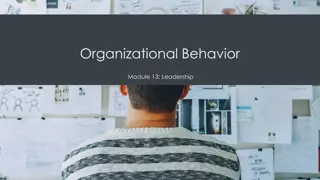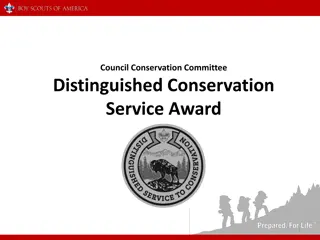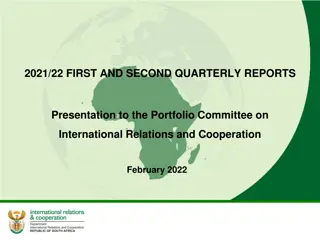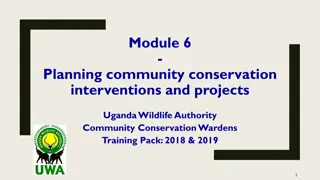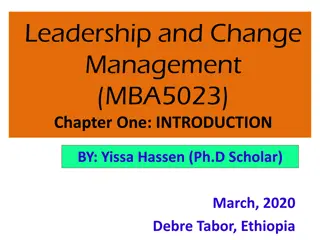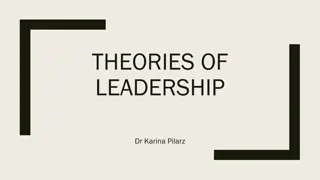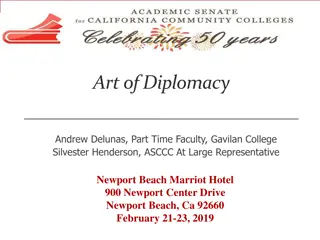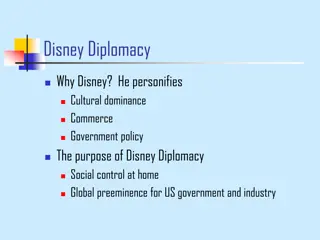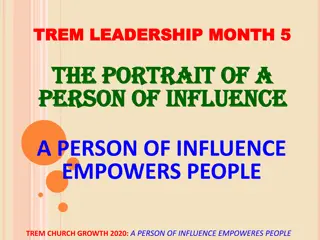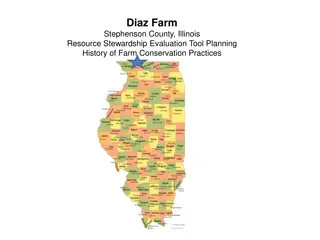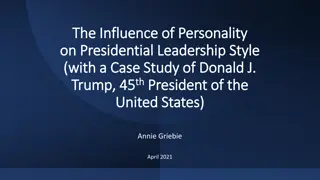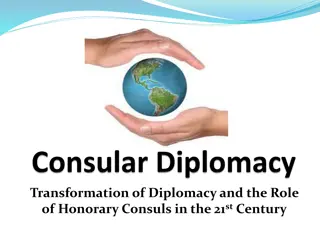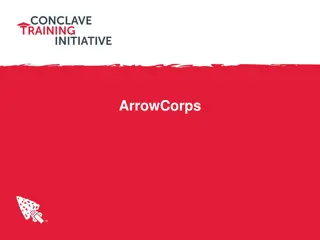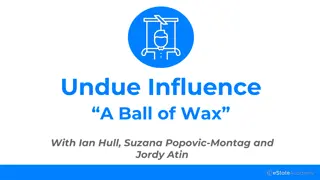Mastering Diplomacy and Influence for Effective Leadership in Conservation
Explore the art of diplomacy and influential leadership strategies essential for emerging conservation professionals. Learn to enhance leadership abilities, understand personal leadership styles, and apply the power of influence to drive success in the preservation of cultural heritage. Discover critical tools for leading teams, communication, conflict resolution, and applying leadership strategies effectively in your world.
Download Presentation

Please find below an Image/Link to download the presentation.
The content on the website is provided AS IS for your information and personal use only. It may not be sold, licensed, or shared on other websites without obtaining consent from the author.If you encounter any issues during the download, it is possible that the publisher has removed the file from their server.
You are allowed to download the files provided on this website for personal or commercial use, subject to the condition that they are used lawfully. All files are the property of their respective owners.
The content on the website is provided AS IS for your information and personal use only. It may not be sold, licensed, or shared on other websites without obtaining consent from the author.
E N D
Presentation Transcript
Leading with Influence: Art of Diplomacy Strategies, Tools & Tactics for Success Leadership Essentials for Emerging Conservation Professionals in the Preservation of Cultural Heritage AIC 47rd Annual Meeting Mohegan Sun, CT New Tools, Techniques and Tactics in Conservation & Collections Care Bob Norris May 14, 2019
Leading with Influence: Art of Diplomacy Strategies, Tools & Tactics for Success Learning Objectives: Build and enhance your ability to be an effective leader and work well with Leaders by understanding critical leadership essentials Discover personal leadership style/traits that can work for you Understand how to apply the Art of Diplomacy to effectively lead and drive success - Learning to use the power of influence & persuasion to accomplish goals and objectives. 2 2
Leading with Influence: Art of Diplomacy Strategies, Tools & Tactics for Success Introductions Name, Organization List 1 Expectation You Want from the Workshop Chose 1 from the Leadership Shield Who do you admire as a Leader and why? How do you like to spend your time/ What is your Personal Motto? What is Unique About You? 3 3
THE INFLUENTIAL LEADER: LEADERSHIP ESSENTIALS 4
Leading with Influence: Art of Diplomacy Strategies, Tools & Tactics for Success Agenda Welcome, Introductions, Objectives The Influential Leader: Leadership Essentials Core leadership principles Leadership styles Critical tools to lead a team: Communication & Dealing with Conflict. The Art of Diplomacy: Influencing for Success Understand the power of influence: how to make it work for you Managing and resolving conflict how to deal with nasties to realize success Bringing it All Together: Applying Leadership Strategies to your world Leadership playbook: LEAD for success 5 5
What is Leadership? "No one can whistle a symphony. It needs someone to direct it; it takes a whole orchestra to play it." . H. E. Luccock At its core, Leadership is inspiring people to follow you; providing them the opportunity to maximize their efforts; to achieve goals and objectives Motivating people Can Identify Leaders who are examples for each of these Roles It is situational Influencing people Commanding people Guiding people 6 6
Leaders are not born! Types of Leaders Leader by the position achieved Leader by personality, charisma Leader by moral example Leader by power held over others Leader who can influence others to follow Intellectual Leader Leader because of ability to accomplish things 7 7
What Makes a Good Leader? Surveys say. Qualities that U.S. workers consider necessary for being a good Leader (in order of importance), according to a recent Yahoo! survey: 1. Communication/listening skills 2. Effective leadership skills 3. Trust in their team members to do their jobs well; Holding others accountable. 4. Flexibility and understanding 5. Coaching and working collaboratively 6. Intelligence 7. Teamwork skills 8. Even temperament 8 8
Leadership Core Principles = Be / Know / Do When people decide to respect you as a leader, they observe what you do so they can know who you really are. People then use this observation to tell if you are an honorable and trusted leader, or a self-serving person who misuses authority. A respected leader concentrates on three key areas: 1. Be -what he/she is, i.e. beliefs and values aligned to the team vision 2. Know - what he/she knows, i.e. job, tasks, human nature 3. Do - what he/she does, i.e. implement, motivate, and provide direction What makes a person want to follow a leader? People want to be guided by people they respect and who have a clear sense of direction. To gain respect, they must be ethical. A sense of direction is achieved by conveying a strong vision of the future. Note: Studies have shown that trust and confidence in leadership is the single most reliable predictor of employee satisfaction. 9 9
Servant Leadership Model Principles of Collaboration A model that attempts to simultaneously enhance the personal growth of workers and improve the quality and caring of our many institutions through a combination of teamwork and community, personal involvement in decision making, and ethical and caring behavior. Conceptualization Foresight Stewardship Commitment to the Growth of People Building Community Listening Empathy Healing Awareness Influence 10 10
The Essence of Leadership is Service to Others On a basic level, as a leader, you exist to: - Inspire others to strive for excellence - Ensure the operating environment is safe, challenging, and fair - Teach, mentor, provide guidance True leaders put the welfare of the group ahead of their own self-interest Selfless does not mean hands-off Know your team Great leaders enhance capability of their organization by driving the actions of others to achieve greatness Leadership is all about helping others to succeed. 11 11
Collaborative Leadership: Art or Science? Supporting High supportive & Low directive Coaching High supportive & High directive Supportive Behavior Delegating Low supportive & Low directive Directing Low supportive & High directive Directive Behavior
The Blend of Art and Science: Collaborative Leadership Collaborative Leadership emphasizes and encouraging the ability to act collaboratively to solve agreed upon issues; Leaders use primarily supportive and inclusive methods to ensure that those they represent are part of the teaming process. Use directive methods selectively to ensure actions happen; Requires a new notion of power from the Leader the more power we share, the more we have to use when we need to use it. I enable your success 13 13
Top Qualities of Collaborative Leaders: Capacity for Organization maturity can manage up and down Patience; coaching and managing conflict when necessary Self reflection; what can we do better Tolerance to handle uncertainty Foresight to understand others point of view and respect others experience or point of view Respectful assessment of team s strength's and weaknesses Creation of a safe, open, supportive environment Communication across boundaries and with every part of the community Living, operating, believing a shared vision 10. Creativity to think outside of the box do something different that goes against organizational norms. 1. 2. 3. 4. 5. 6. 7. 8. 9. 14 14
Six Practices of Collaborative Leadership Leader Qualities/Skills that Will Help Drive Influence Understanding the context, the problem for change before you act. Assessing the Environment Defining the goals, shared values and engaging people in positive action. Creating Clarity Developing synergy of people, organizations, and communities to accomplish a shared vision. Sharing Power and Influence Understanding your own values, attitudes, and behaviors as they relate to your leadership style and its impact on others. Self-Reflection Creating safe places for developing shared purpose and action. Committing to people as a key asset through coaching and mentoring. Building Trust Developing People 15 15
The Collaborative Leader Capabilities Development Checklist Leaders let their natural talents to prevent them from transforming their organization. Leadership takes over where authority leaves off: Leaders coach growth Leadership is about results, but not at all costs. Leaders must provide alignment Leaders must create accountability. Leaders demand sustainability. Leaders excel at integrative thinking. Leaders communicate the strategic plan with clarity to all employees to drive ownership and for them to see a line-of-sight. Leaders embrace management processes linking strategy with execution Leaders expect and instill a disciplined implementation approach involving all employees Leaders have a commitment to drive change; when needed demonstrate courage to do what is right Leaders constantly reinforce the message through regular communication While Leaders will incent employees through rewards & recognition to align employees and maintain momentum.; they are prepared to explain the consequences when things to not meet expectations. 16
Focusing on a few key qualities and incorporating them into every action increases leadership effectiveness There is no standardized approach to effective leadership Effectiveness as a leader is directly proportional to how well the key qualities you focus on align with your values and your personality Research indicates these are qualities of a great leader: 1. Maintains and demonstrates strong convictions to her/his principles 2. Develops and communicates a clear, winning vision 3. Builds trust through transparency, and integrity 4. Is visible: creates/promotes a high performance culture 5. Believes in service to people: coach, teach, empower, grow 6. Convinces rather than controls 7. Builds commitment vs. imposes compliance 8. Continually learns What qualities of a leader fits you or you aspire to be? 17 17
Summary: Exercise Self Reflection The role of a leader is more critical than ever Do you agree with this statement? Yes or No Why? What will be your leadership legacy? How would you want someone to describe the type of leader you are? Identify the style of leadership you aspire to practice. What is 1 take-away to help you work on towards building more effective leadership skills 18 18
Leadership Tools: Communications & Dealing with Conflict 19 19
When is the Right Time? Communication begins early and is a dynamic process... Vehicles Vehicles, key messages, audiences and feedback mechanisms must be managed as a system rather than as a random, disconnected process Message Need Identified Messenger Key Audiences Measurement / Feedback Vehicles 20
Communications Lessons from Leaders "The single biggest problem in communication is the illusion that it has taken place." George Bernard Shaw 1. Be clear and concise. Overwriting and using technical jargon will lead to confusion and misunderstanding. Talk in mere mortal terms 2. Set the tone at the top. Leaders need to set the tone. They need to be visible and accessible, and they need to understand that there's a correlation between strategic employee communication and the achievement of organizational goals. 3. Understand your employees. You may need to communicate differently with different audiences. For those who don't use computers at work, email is ineffective. To determine your employees' needs and perceptions, consider surveying them regularly: Are they getting the information they need? 21
Communications Lessons from Leaders 4. Use many channels. Most people need to hear or see a message multiple times, in multiple ways, to understand it completely. Distribute your messages electronically, in writing, face to face, and at forums and meetings. Your message should be consistent across all these channels. 5. Provide context. Employees need to hear information at multiple levels. Provide context (what external factors are at play?); explain strategy (why did we decide to respond this way?); and make it personal (how will this affect me?). 6. Be timely: Notify employees and colleagues first! When you prioritize your communications, always think of your internal people first. Your employees should hear it from you before they hear it from anyone else; they shouldn't be surprised by a media report. 22
Communications Lessons from Leaders 7. Be forthcoming, and be continuous. Always communicate, and communicate both good and bad news. If you are honest and candid in sharing bad news, your good news is more credible. 8. Match actions with words. If you say you will address a situation in a certain way, do it. If you don't, you're undermining your credibility. 9. Emphasize face-to-face communications. Although today's employees may be more tech-savvy than ever, nothing beats human interaction. Most employees want to hear news and information from their supervisors. Managers need to be trained in how to communicate, and they need to have the right tools at hand. If you are expecting your managers to help explain a complicated change or concept, you'd better provide them with talking points. 23
Communications Lessons from Leaders 10. Create an organizational habit for communications. You know you need to communicate about policies; health and safety; benefits; and how a job should be carried out. But remember that you also need to share information about your organization what our your objectives? How are you performing? What are your plans and prospects? How can employees help? 11. Plan. Be systematic and strategic. Have an editorial calendar that spells out what you'll say, and when, where, and how you'll say it. Develop a checklist of what needs to be communicated. Use a communication planning template. 12. Measure effectiveness. Set objectives, and be prepared to assess whether you have met them, as well as whether they are employee engagement goals or perception goals. You might want to regularly assess engagement levels and ask employees whether the organization has communicated its strategy well. Do they understand how their daily work helps the organization meet its goals? 24
Communications Lessons from Leaders 13. Facilitate conversation.Listen, Listen, Listen One-way communication is a thing of the past. Individuals are empowered to talk back, and feeling "listened to" enhances feelings of trust. There are many ways to facilitate two-way communication, including face-to-face meetings; "town hall" meetings; interactive video interviews; Twitter questions; employee surveys; Q&A features on the employee intranet; and anonymous suggestions via email or suggestion boxes. 14. Be objective.Don t Spin it. Don't "spin," or try to dictate or assume how people should feel about the news you're sharing. 15. Say "thank you" as much as possible. If an employee or colleague feels appreciated, he/she's more likely to feel engaged. 25
Exercise - The Elevator Speech Develop a compelling and concise speech about Who you are as a Leader . including: 1. Why is Leadership important 2. Describe your leadership style 2-3 elements that will be your leadership legacy 3. What you ve learned from your experiences: The Good, Bad, & Ugly 4. How will your Leadership make people s lives better 5. Be prepared to present out to the class You ll need your speech often In the hallway, at meetings and maybe even in an elevator 26
Conflict: Address it head on! Resolved = Commitment Unresolved = Conflict, Compliance, Collapse Ever tried. Ever failed. No matter. Try again. Fail again. Fail better Owen Dougan 27
Conflict: Recognizing different types Non- Productive Competitive Climate Members perceive disagreement as a game in which someone will win and others must lose No alignment among team members with the goals of the team. No sense of team spirit .. One for me, Me for One Team members are locked into their own viewpoint and are unwilling to consider others ideas. Team members resort to personal attacks instead of focusing disagreements on issues It may be impossible to reach any decisions because the team becomes deadlocked. Productive Cooperative Climate Team members realize disagreements stem form sincereinvolvement with a common problem and the belief that the problem can be solved Commitment to team goals need to accomplish the team mission Members are supportive of others ideas and open to considering merits of opinions different from their own. Disagreements are confined to issues and do not involve personalities. Team members usually are able to reach decisions that they are proud ofand that satisfy the whole team 28 28
Dealing with Conflict How can you Lead? Process Conflict Role Conflict Ask yourself, How much control do I have over this process conflict? Ask yourself, Exactly how do I perceive my role in relation to others involved in this issue? Take responsibility for clarifying your role with others involved. Be prepared to change your perception of your role. Show your willingness to be flexible in achieving your organization s goals. Stay positive. View any role change in terms of the opportunities it presents. Identify the root cause of the problem and analyze the improvement opportunity. Talk first to the owner of the process. Describe the current problem and get agreement. Suggest a workable solution and action plan. Follow-through on the plan and give recognition to the owner of the process. 29 29
Dealing with Conflict How can you Lead? Interpersonal Conflict Direction Conflict Ask yourself, How much do my personal biases and prejudices affect this relationship? Ask yourself, Am I clear on the direction or vision? Clarify the discrepancy so that it can be easily described in neutral words and take action. Write down three behaviors that you could change in order to reduce the conflict in this relationship. Commit to following through on these changes for at least three months. Ask permission to address the discrepancy with the other person in a friendly, non-confrontational way and gain agreement. Ask the other person involved how you could defuse the existing conflict. Encourage feedback that might seem brutally honest. Use I and we messages rather than you messages. Put yourself in their position. How do you think they view your commitment to reducing conflict in your relationship? Why? If there is a difference in values, always go with the higher value. Make authentic commitments. Make a list of 5 strengths that you see in the other person. Then list five ways that improving this relationship would benefit you. 30 30
Dealing with Conflict How can you Lead? External Conflict Ask yourself, How much control do I have over this factor? Choose to fight battles that are worth the price. Put your energy into things you can do rather than complain about what you can t do. Do something good for others. Maintain perspective and a sense of purpose. Talk to someone you trust. 31 31
Conflict: Team Nasties -- Disruptive Personalities / Bad Behavior Demonstrated Behaviors Team Nasties Always agreeing on everything all the time. Passive resistance to avoid doing anything meaningful. Poor follow-through Super Agreeables Know everything about anything. Likes to debate and put you down because you just don t know what he/she knows. (pure power move) Creates perception that his/he opinions are supported by true facts. Condescending . Insecure and hides behind knowledge Know-it-Alls Procrastination. Continuously states all that they are doing juggling too many things. Inconsistent follow-through. Completes tasks but most of the time misses deadlines. Convinces others to delay Stallers Blocker Nothing is ever right here. Glass is always half-empty. Complains and whines about EVERYTHING. Nothing is ever right. Always bringing up that we have done that before and ... it has never worked Complainers/Whiners Debbie Downer Anything that you say it is shot down. Manipulates words to supports his/her opinion and wound your credibility. Never held accountable for actions. Passive aggressive. Best friend of the Know-it-All. Idea Snipers Super aggressive-- will roll right over you, and not care what damage has been done. Must always be right. Dominant personality. Huge ego. Will argue until he/she wins. Will intimidate others to follow him/her. Looks for ways to undercut the leader if there is a disagreement. Tanks 32 32
Conflict: How do we Cope with Difficult People Primary Behavior How to successfully Deal with Team Nasties Super Agreeables Always agreeing on everything all the time. Talk about their interests Suggest options/alternatives Focus on a solution Know everything about anything. Be well-prepared deal with facts/data Listen and paraphrase Don t challenge/ask questions Know-it-Alls Procrastination. Completes tasks but most of the time misses deadlines. Help them to be honest Help them solve problems Work on a win-win solution Stallers Blocker Complains and whines about EVERYTHING. Nothing is ever right. Don t be defensive Listen, acknowledge. Don t argue Encourage them to own the solution Complainers/Whiners Debbie Downer Anything that you say it is shot down. Address the behavior openly Ask others if disagree with the criticism Address sniping head on Don t let them hide behind humor/sarcasm Idea Snipers Super aggressive-- will roll right over you, and not care what damage has been done. Stand up to them - a non-combative way Don t argue/ present facts Get them to problem solve Tanks 33 33
The Art of Diplomacy: Influencing for success Diplomacy is the art of letting someone else have your way Daniele Vare Leadership is the art of getting someone else to do something you want done because he/she wants to do it. Dwight Eisenhower. Topics to be addressed: Power of influence: Executing the Influence Model Enhanced Influence: Managing and resolving conflict Exercise: how to influence your boss for collective success
Leading with Influence = Identifying your Power Let s review . The source of Power in any organization is: Position Relationships Personal Leaders understand the power they have and how to be comfortable using it to make a difference for others and, to achieve objectives/goals. How do you define these? What are examples? 35 35
Personal Power Profile Improve to Influence Power Trait Trustworthiness Definition + - 0 Speaks the truth; transparency Understands value - give & take Ability to relate well w/others Expertise that others value Knowledge, technical expertise Shares views and is compelling Communication skills Contributions merit admiration Accomplishments Engaging style to energize others Personal Charisma Anticipating, thinking ahead Ideas that are impactful Not easily diverted or discouraged Focus and enthusiasm Collaborates with colleagues A wonderful team member Not shy to speak up with respect Self Confidence Tireless in pursuit of key goals Energy and endurance Follows up Can be counted on Reliable Total in each category + = comfortable practicing trait 0 = neutral in practicing trait - uncomfortable practicing this trait 36 36
Persuasion vs. Influence - It Depends Similar yet different as to when it is used Persuasion It is reasoning based so that they would believe or do something Mostly used in negotiation context for a buy/sell transaction Relies on a heavy-dose of direct (1:1) communications to cajole or convince someone to do what you want to do Perception of persuasion is it is more Coercion based Has elements of an authority leader characteristic Plays to the Power of Position Influence It is the ability to affect the manner of thinking of another. Mostly used in a leadership context to build commitment Heavily dependent on trust, credibility and relationships Influence may work without any direct communication, and the individuals are motivated to do what the leader wants. Has elements of a coach or affiliated leader characteristic Plays to the Power of Relationships and Personal 37 37
Influence Defined Influence is The ability to change, direct, or affect the behaviors of others without ordering or threatening them. It is something you actively do to make a difference to enlist support to accomplish your goals and objectives 38 38
Influence - Core Principles The key to influence is based on a principle that underlies all human interaction, the Law of Reciprocity - people should be paid back for what they do. Influence is all about trades, exchanging something the other values in return for what you want. Relationships matter! The more good ones you have the greater the odds of you finding the right individuals to trade with improves the odds you have the ability to add goodwill to increase the chance of you obtaining what you want or need. Influence requires that you know what you are doing, have reasonable plans, are competent and respected for what you do. This is the price of admission. You have to want influence for the ultimate good or our organization, department or team. Just about everybody is potentially much more influential than they think they are. If you are bashful You won t be able to influence. 39 39
The Influence Model How to be a Leader without Authority Influence is the ability to change, direct, or affect the behaviors of others without ordering or threatening them. Walk in the shoes of the other person who would be an ally Identify relevant currencies: yours, theirs Assume all are potential allies Clarify your goals and priorities Influence through give and take Deal with relationships Influence is all about trades, exchanging something the other values in return for what you want Adapted from Influence Without Authority by Cohen and Bradford 40
When to use the Influence Model Conditions to use Model 1. Other person is resistant 2. Don t know the other person and what you are asking might be costly 3. You have a poor relationship with the other person or group or you are in a group that that has a poor relationship 4. You might not have another shot at the golden ring. 5. You have tried everything else but the other person still refuses what you want Walk in the shoes of the other person Identify relevant currencies: yours, theirs Assume all are potential allies Clarify your goals and priorities Influence through give and take Deal with relationships who would be your ally Adapted from Influence Without Authority by Cohen and Bradford 41
Influence Model Building Allies Assume all are potential allies Walk in the shoes of the other person who would be an ally Identify relevant currencies: yours, theirs Clarify your goals and priorities Influence through give and take Deal with relationships Key Points Begin by discovering if there are any overlaps so you have the basis to form an alliance Determine if there could be an alliance that would benefit your boss Don t assume if the other person is resisting they are an adversary Adapted from Influence Without Authority by Cohen and Bradford 42
Influence Model Clarifying Goals Walk in the shoes of the other person who would be an ally Clarify your goals and priorities Identify relevant currencies: yours, theirs Assume all are potential allies Influence through give and take Deal with relationships Key Points Determine what your core objectives ( must haves needs) are to influence change so not to be sidetracked by the pursuit of secondary objectives ( nice-to-haves needs). Determine if short term gains are worth more than the longer term benefits of a better relationships or making a larger impact with something that the organization really needs Clarification of goals helps sort personal desires from what is truly necessary on the job or for the organization. It helps mitigate the risk that your personal concerns will become central and interfere with more important organizational goals 43
Influence Model Know your Ally Walk in the shoes of the other person who would be an ally Identify relevant currencies: yours, theirs Assume all are potential allies Clarify your goals and priorities Influence through give and take Deal with relationships Key Points Determine the organizational situation of the ally that drives what they care about. Key organizational forces to be considered that may impact the ally s ability to commit include: how a person is measured and rewarded, who are the ally s peers and supervisors, where the person is in their career Diagnostic activity helps overcome tendency to blame personality as a reason they do not become an ally. This can prevent demonizing vs. seeing a potential ally 44
Influence Model Assess Currencies Identify relevant currencies: yours, theirs Walk in the shoes of the other person who would be an ally Assume all are potential allies Clarify your goals and priorities Influence through give and take Deal with relationships Key Points Determine the currencies that the ally would consider of value usually they care about more than one thing (prestige, $$$, being liked). Gives you more to exchange Assess your resources relative to the Ally s wants to provide you options to barter. You lose influence by failing to see the wide range of currencies you do have to offer 45
Currencies Inventory What you might have that you can exchange Position- Related Personal- Related Inspiration-Related Recognition Visibility Reputation Insider-ness Contacts Compelling Vision Drive for Excellence High Quality Work Moral/Ethical Standards Success breeds Success Gratitude Ownership/involvement Self-concept or worth Comfort Growth Task-Related Relationship- Related New resources ($$$/people) Challenges/Learning Assistance/Help Organizational Support Rapid Response Information sharing Community sharing Being heard by others Acceptance /Friendship Inclusion Emotional support 46
Influence Model Work Relationships Walk in the shoes of the other person Identify relevant currencies: yours, theirs Assume all are potential allies Clarify your goals and priorities Influence through give and take Deal with relationships Key Points Assess what is the nature of your relationship with the person positive, neutral, or negative Assess how does the potential ally want to be related to before you launch into a discussion You will have more influence if you use an approach the person is comfortable with 47
Build Strong Relationships: Tips for Success 1. Seek solutions that are mutually beneficial 2. Know your colleagues, team s strengths 3. Understand the culture of how things work 4. Anticipate concerns that emanate the fear of loss 5. Recognize that influence requires developing relationships 6. Leading with influence is based on the concept that parties involved must contribute to the solution 7. Seek opportunities that identifies differences and determines ways to resolve the differences 8. Be grateful for conflicting and opposing questions and comments 9. Bridge ideas to create unity consensus technique 10. Bring facts and data to the discussion and to support your needs. 48 48
Influence Model Making Exchanges Walk in the shoes of the other person Identify relevant currencies: yours, theirs Assume all are potential allies Clarify your goals and priorities Influence through give and take Deal with relationships who would be your ally Key Points Don t discount the Law of Reciprocity and its impact on the exchange Consider the following as you determine what to exchange: (1) attractiveness of your resources; (2) the ally s needs for what you have; (3) your desire for what the ally has; (4) your organization and their unwritten rules about how to explicitly express what is needed; (5) your willingness to take chances to pursue what you want. 49
Self-Created Barriers to Influencing Awareness of what is a must do and a not to do Not-to-do Must-do (if not a Barrier) Ensure you walk in their shoes know the world they operate in and be aware of the constraints they have to deal with daily. Do a solid analysis of your currencies and what the ally may need to decide on supporting what you need done. Determine how you want to make trades and then do it. Do not assume the other person is at least a potential ally. Do not minimize the importance of clarifying your goals and prioritizing them. Do not underestimate the need to invest time in building relationships as part of what you do and how you operate. Remember the Law of Reciprocity! Potential BARRIERS 50



